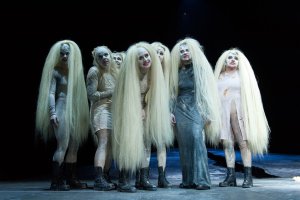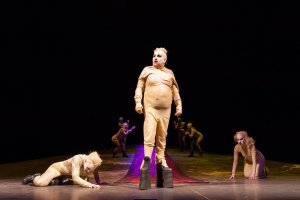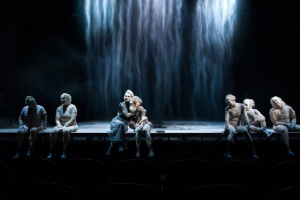Die Orestie
Director: Antú Romero Nunes
Writer: Aeschylus, translated by Peter Stein
Cast: Sarah Viktoria Frick, Maria Happel, Caroline Peters, Barbara Petritsch, Aenne Schwarz, Irina Sulaver, Andrea Wenzl
Seen on: 2.4.2017
Plot:
After Agamemnon (Maria Happel) returns home from war with Kassandra (Andrea Wenzl) as his trophy, his wife Klytameistra (Caroline Peters), who is living with Aigisthos (Barbara Petritsch), kills Agamemnon and Kassandra both, to avenge Agamemnon’s killing of Iphigenie, their daughter, a continuation of the family curse that weighs on Agamemnon due to his father and uncle sacrificing their own children to the gods. Agamemnon and Klytameistra’s son Orestes (Aenne Schwarz) vows to revenge the murder of his father too, continuing the spiral of blood and violence.
The production of the Oresteia walks the line between traditional setting and modern sensibilities. Ultimately it is visually striking and well-acted, but maybe a little too conservative.

The production works on an almost empty stage in front of a simple black wall, but the few elements it does use, it uses very effectively. There’s a river of blood, sand rains down and the ground shifts. It’s all rather elemental and thus provides the perfect background for the seven Erinyes, furies, who form the choir of the play: their white costumes, long blond hair and white make-up are both reminiscent of antiquity (or at least what comes to mind when we think of old Greece nowadays) and are something entirely different and modern.
The cast does those roles and costumes complete justice. There’s something visceral about the Erinyes – and that’s a quality they desperately need. But the same seven women also play all the other roles in the play, morphing from one role to the other with the help of props and incomplete costume changes.That the transformation from fury to human remains incomplete definitely works in favor of the play.

It was also interesting to have only women acting on stage, especially when, at the end, the furies are forced into colorful dresses under the new rule of law. Their savage nature may be covered, but it is certainly not gone. The savage nature of humans under civilization’s disguise is usually a topic explored for men and not women. In the end, though, the furies are put under (symbolic) lock and key, having apparently inspired others to do violence and the man who actually set the violent action gets off. The establishment of courts is celebrated in the text, the play remains more ambiguous, but at this point it felt that the critical eye of the play overlooked the gender aspect of this.
Or maybe I was too tired by that point, since it is a bit of a tour de force to watch this play (probably even more to play it). Especially since a lot of the text is actually spoken in a chorus by all actors which makes it more difficult to listen to. It was a strong production, but it was also more work than might have been strictly necessary.

Summarizing: Worth seeing, yes.
Advertisements Share this:




